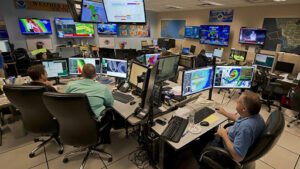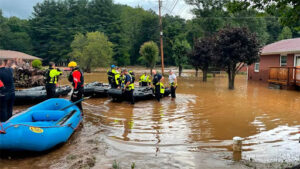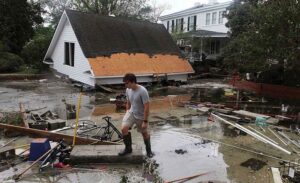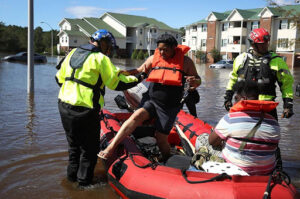Coastal North Carolina, with its picturesque landscapes and vibrant communities, also faces a unique challenge – frequent flooding due to its proximity to the Atlantic Ocean. Staying informed during coastal North Carolina floods is not just an option; it’s a crucial aspect of ensuring the safety and well-being of residents.
Coastal Flood Risks in North Carolina
 Image Source: USGS
Image Source: USGS
Coastal regions of North Carolina face significant flood risks, primarily driven by the frequent occurrence of hurricanes and tropical storms. These natural events, often intensified by rising sea levels, high tides, and heavy rainfall, constantly threaten the coastal communities. The vulnerability to flooding in this region is further exacerbated by its proximity to the Atlantic Ocean.
Seasonal Variations and Typical Flood Patterns
Understanding the seasonal variations and typical flood patterns in coastal North Carolina is vital for residents and authorities alike. Coastal flooding is not a one-size-fits-all phenomenon; it can vary throughout the year. Different seasons may bring different flood risks, and comprehending these patterns can aid in preparedness.
Whether it’s the increased likelihood of hurricanes during the Atlantic hurricane season or the potential for localized flooding during heavy spring rains, staying informed about seasonal variations is crucial.
Potential Consequences of Inadequate Preparation
The potential consequences of inadequate preparation for coastal North Carolina floods are severe and far-reaching. Failing to stay informed and take proactive measures can have dire consequences. Lives can be endangered as individuals and families may find themselves unprepared and at risk during a flood event.
Property damage can be extensive, causing financial hardship for homeowners and communities. Moreover, inadequate preparation can disrupt entire communities, straining resources and emergency response efforts. The repercussions of not taking flood risks seriously can be both immediate and long-lasting, emphasizing the importance of staying informed and prepared.
Reliable Information Sources
 Image Source: GBH
Image Source: GBH
When it comes to staying informed during coastal North Carolina floods, having reliable sources of information is paramount.
Government Agencies and Organizations:
Government agencies and organizations play a crucial role in disseminating accurate and up-to-date information. The National Weather Service (NWS), for instance, provides comprehensive weather forecasts, warnings, and advisories that are specific to your location.
These agencies employ cutting-edge technology and expertise to monitor and predict coastal weather conditions, ensuring you receive timely and precise information to make informed decisions.
Local News Outlets and Meteorologists:
Local news outlets and experienced meteorologists who specialize in tracking coastal weather patterns are invaluable resources. They often offer the latest updates and insights into the unique dynamics of coastal weather systems. Their in-depth knowledge of the region can provide context and help you understand the potential impacts of impending weather events.
Tuning in to local news broadcasts or following these experts on social media can keep you well-informed throughout the flood threat.
Smartphone Apps and Weather Alerts:
In today’s digital age, smartphone apps, and weather alerts have become indispensable tools for staying informed. These applications provide real-time updates and emergency notifications directly to your mobile device. By downloading a weather app and enabling alerts, you can receive critical information promptly, allowing you to respond swiftly to changing conditions.
Community-Based Resources:
Beyond official sources, community-based resources can be highly valuable. Neighborhood watch groups and online forums offer platforms where residents share information, experiences, and insights related to local flood conditions. These grassroots efforts can provide a sense of community and offer a wealth of practical tips and advice based on firsthand experiences.
Engaging with such resources can enhance your understanding of the situation and foster a spirit of collaboration within your community, making everyone better prepared to face coastal North Carolina floods.
Incorporating these reliable information sources into your flood preparedness plan ensures you have access to the most accurate and timely updates, enabling you to make informed decisions and stay safe during flood events.
Pre-Flood Preparedness
 Image Source: Wikipedia
Image Source: Wikipedia
When it comes to dealing with coastal North Carolina floods, proactive pre-flood preparedness is the key to safeguarding yourself and your loved ones.
Creating a Family Emergency Plan:
One of the foundational steps in pre-flood preparedness is creating a family emergency plan. This plan should cover various aspects, including communication, evacuation routes, and meeting points.
Establishing clear communication channels ensures family members can stay in touch during an emergency, even if separated. Identifying evacuation routes and designated meeting points provides a structured approach to ensuring everyone’s safety. A well-thought-out family emergency plan can be a lifeline during a flood event.
Assembling a Disaster Supply Kit:
Assembling a disaster supply kit is another critical element of pre-flood preparedness. This kit should contain essential items such as water, non-perishable food, medications, flashlights, batteries, and important documents.
These readily available supplies ensure you are prepared to sustain yourself and your family in case of flooding or a disaster. It’s essential to periodically check and update your disaster supply kit to ensure its contents remain fresh and relevant
Securing Your Home and Belongings:
Securing your home and belongings is vital to minimize potential damage during a flood. Implementing flood mitigation measures, such as elevating electrical systems and using sandbags or flood barriers, can help protect your property.
Additionally, securing outdoor items and potential projectiles, like furniture and garden equipment, can prevent damage during high winds and heavy rains. A proactive approach to safeguarding your home and belongings can make a significant difference in the aftermath of a flood.
Evacuation Routes and Plans:
Familiarity with local evacuation routes and plans is essential. Know how to access these routes and be aware of any changes or updates that authorities may provide during a flood event. Identify the locations of emergency shelters in your area and the procedures for seeking refuge there if necessary.
Being well-informed about evacuation routes and plans ensures that you can make informed decisions in the event of a mandatory evacuation, maximizing your safety and that of your family.
Incorporating these pre-flood preparedness measures into your life equips you with the knowledge and resources needed to respond effectively in the face of coastal North Carolina floods.
During the Flood
 Image Source: CNN
Image Source: CNN
In the midst of a coastal North Carolina flood, your safety hinges on a few critical actions. Continuously monitor weather updates with a keen eye on storm tracks and flood warnings, as conditions can change rapidly.
Understanding the significance of different flood alerts, such as watches, warnings, and advisories issued by authorities, is vital for making informed decisions. If authorities recommend evacuation, follow their guidance meticulously, heading to designated emergency shelters while ensuring you have your disaster supply kit in tow.
Equally important is staying connected with loved ones, maintaining communication to share your whereabouts and safety status, and providing reassurance and peace of mind in these challenging times.
After the Flood
 Image Source: ENR
Image Source: ENR
Once the coastal North Carolina flood has subsided, the focus shifts to recovery and ensuring safety in the aftermath. Assessing damage and safety should top your list of priorities. Before returning to your property, thoroughly check if it’s safe. Be vigilant for potential hazards, like downed power lines and contaminated water, which can pose significant risks.
Accessing recovery resources and assistance is crucial. Reach out to disaster relief organizations and government agencies that can support you to rebuild and recover. They can offer valuable guidance and resources to help you navigate the challenging process of post-flood recovery.
Additionally, it’s essential to be mindful of health concerns after a flood. Water contamination and mold growth are common issues that can affect your well-being. Follow safety guidelines for cleanup and recovery to protect yourself and your family from potential health risks. In the aftermath of a coastal North Carolina flood, a thorough assessment, access to recovery resources, and vigilant health precautions are key to the path of recovery and restoration.
Community Engagement
 Image Source: Inside Climate News
Image Source: Inside Climate News
Community engagement is a pivotal aspect of coastal North Carolina flood resilience. By actively participating in local flood awareness initiatives, you contribute to community preparedness and benefit from shared knowledge and experiences. Volunteering with groups that promote flood resilience fosters a sense of unity and shared responsibility within your community.
Participating in flood preparedness drills and exercises is another proactive step toward enhancing your readiness. These events provide hands-on experience and valuable insights into responding effectively to flood situations. It’s an opportunity to practice what you’ve learned and collaborate with neighbors and local authorities.
Supporting flood resilience efforts at the local level is an essential commitment. By advocating for infrastructure improvements and floodplain management, you can help reduce the risks associated with coastal North Carolina floods. These efforts are essential for creating a safer and more resilient community, ensuring that future generations can better withstand the challenges posed by flooding.
Conclusion
Staying informed during coastal North Carolina floods is your key to safety and resilience. By understanding the risks, relying on reliable information sources, and taking proactive steps to prepare, you can confidently navigate the storms. Remember, it’s not just about surviving the flood; it’s about thriving in its aftermath and building a more resilient community for the future. Stay informed, stay prepared, and stay safe.



Leave a Reply